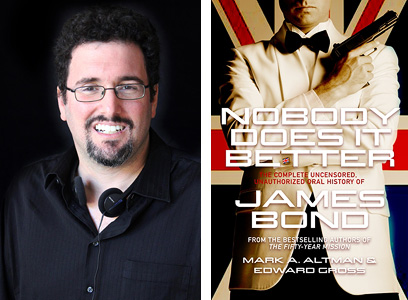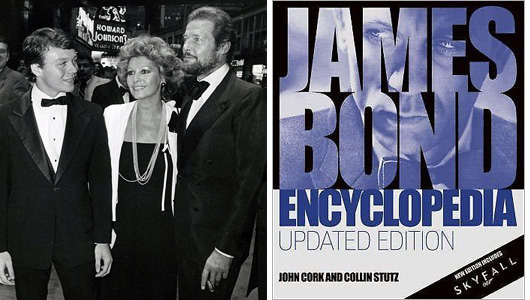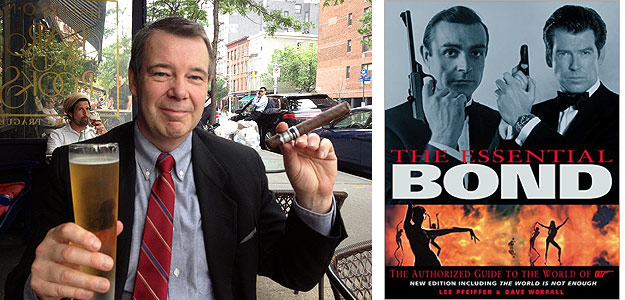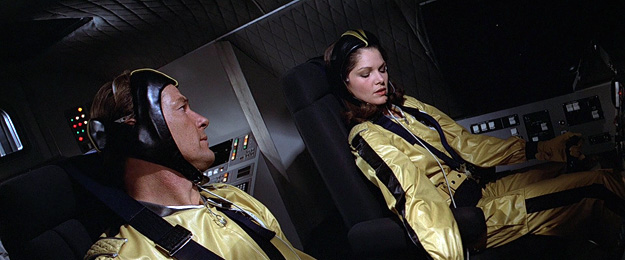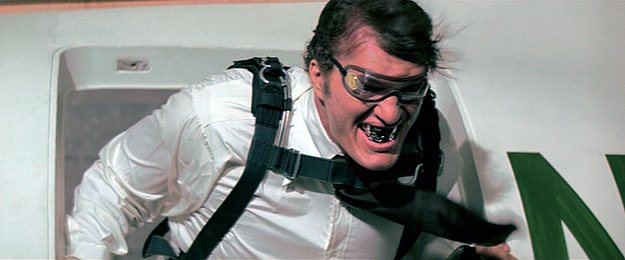“I remember thinking as Bond tumbled out of the airplane that this was going to be the greatest film ever. And then, moments later, Jaws flapped his arms falling toward a circus tent. I felt my own internal seismograph plummet. I was for the first time in my life, embarrassed for the filmmakers of a James Bond film.” — John Cork, co-author of James Bond Encyclopedia
The Digital Bits and History, Legacy & Showmanship are pleased to present this retrospective commemorating the 40th anniversary of the release of Moonraker, the 11th (official) cinematic James Bond adventure and the fourth of seven to feature Roger Moore as cinema’s most popular secret agent.
Our previous celebratory 007 articles include Quantum of Solace, From Russia with Love, Never Say Never Again, Live and Let Die, Octopussy, Casino Royale (1967), Tomorrow Never Dies, Die Another Day, Dr. No, The Living Daylights, The Spy Who Loved Me, You Only Live Twice, Diamonds Are Forever, Casino Royale, For Your Eyes Only, Thunderball, GoldenEye, A View to a Kill, On Her Majesty’s Secret Service, Goldfinger, and 007… Fifty Years Strong.
The Bits continues the series with this retrospective featuring a Q&A with an esteemed group of film historians and James Bond authorities who discuss the virtues, shortcomings and legacy of 1979’s Moonraker. [Read on here...]
The participants for this segment are (in alphabetical order)….
Mark Altman is co-author of the upcoming James Bond oral history Nobody Does It Better with Edward Gross from Tor/Forge which will be released in hardcover early next year. He is the creator and executive producer of the new sci-fi TV series, Pandora, which debuts on the CW and around the world, on Tuesday, July 16th at 8 PM, as well as a writer/producer for such series as Castle, The Librarians and Agent X and co-writer/producer of the romantic comedy Free Enterprise, starring William Shatner and Eric McCormack. Altman is the co-host of the popular podcasts, The 4:30 Movie (where he selected Moonraker as his pick for “In The Shadow of Star Wars Week”) and Inglorious Treksperts, the only podcast for Star Trek fans with a life. Other oral history collaborations with Edward Gross include So Say We All: The Complete, Uncensored, Unauthorized Oral History of Battlestar Galactica (Tor Books, 2018), The Fifty-Year Mission: The Complete, Uncensored, Unauthorized Oral History of Star Trek (two volumes; St. Martin’s Press, 2016) and Slayers & Vampires: The Complete, Uncensored, Unauthorized Oral History of Buffy and Angel (Tor Books, 2017).
John Cork is the author (with Collin Stutz) of James Bond Encyclopedia (DK, 2007) and (with Bruce Scivally) James Bond: The Legacy (Abrams, 2002) and (with Maryam d’Abo) Bond Girls Are Forever: The Women of James Bond (Abrams, 2003). He is the president of Cloverland, a multi-media production company, which has produced, among other projects, Value Added Material for home media releases (including several of the James Bond movies). Cork also wrote the screenplay to The Long Walk Home (1990), starring Whoopi Goldberg and Sissy Spacek. He wrote and directed the feature documentary You Belong to Me: Sex, Race and Murder on the Suwannee River for producers Jude Hagin and Hillary Saltzman (daughter of original Bond producer, Harry Saltzman). He contributed new introductions for the original Bond novels Casino Royale, Live and Let Die, and Goldfinger for new editions published in the UK by Vintage Classics in 2017.
Lee Pfeiffer is the author (with Dave Worrall) of The Essential Bond: The Authorized Guide to the World of 007 (Boxtree, 1998/Harper Collins, 1999) and (with Philip Lisa) The Incredible World of 007: An Authorized Celebration of James Bond (Citadel, 1992) and The Films of Sean Connery (Citadel, 2001). Lee was a producer on the Goldfinger and Thunderball Special Edition LaserDisc sets and is the co-founder and Editor-in-Chief of Cinema Retro magazine, which celebrates films of the 1960s and 1970s and is “the Essential Guide to Cult and Classic Movies.”
The interviews were conducted separately and have been edited into a “roundtable” conversation format.
And now that the participants have been introduced, might I suggest preparing a martini (shaken, not stirred, of course) and cueing up the soundtrack album to Moonraker, and then enjoy the conversation with this group of James Bond authorities.
Michael Coate (The Digital Bits): In what way is Moonraker worthy of celebration on its 40th anniversary?
Mark A. Altman: Moonraker, despite the many slings and arrows that have been shot at it over the years, is incredibly significant in many ways. First, it was an immensely profitable entry in the Bond canon and in many ways the biggest of the “bigger is better” Bond canon which includes You Only Live Twice, Die Another Day and Spectre. It’s probably the best example of mission creep in which the producers throw everything but the kitchen sink in a late era Bond actor’s oeuvre to try and top themselves and it rarely works out. Hence: the paragliding sequence in Die Another Day. That said, Moonraker is an immensely enjoyable film with some of the greatest set pieces in the series’ history despite being undercut by an abundance of unfortunate humor (to wit: the double-take pigeon) and one of the best and most lyrical of John Barry’s many magnificent scores. The other more intriguing nugget is it’s a great example of old-fashioned miniature works which was unique because it didn’t involve an optical printer and motion control, but rather multiple passes of myriad elements in camera and unlike the effects of a film like GoldenEye over a decade later (or Die Another Day two decades later) are utterly flawless. It’s also heartbreaking that this is Ken Adam’s last Bond movie. It’s probably his best looking film (with You Only Live Twice and Spy a close second) and none of the subsequent Bonds would ever reach the incredible highs of Adam’s genius.
John Cork: When you look at a seismograph record of an earthquake, you see the black lines jumping up and down off the center in a frantic and frightening way. Moonraker is like that. The highs are spectacularly high. The lows are soul-crushing. The rapidity with which the film oscillates from edge-of-your-seat awe to brow-slapping indignity is, in itself, an achievement. It was everything right and wrong with James Bond in 1979. Despite its nods to the women’s movement, it lasciviously embraces the creepy sexual imperialism of the Roger Moore era just as casually as it ham-handedly embraces crass product placement.
In many ways Moonraker feels like Eon’s attempt to move in on the territory tread by the 1967 Casino Royale. Vesper Lynd in that film has purchased Nelson’s Column from Trafalgar Square, whereas Drax has purchased the Eiffel Tower in Moonraker. The space battle plays remarkably well with the Bacharach track The Big Cowboys and Indians Fight at Casino Royale (anyone who wants to test this should start right as Bond hits the “gravity button,” and watch in wonder as the music ends just as Bond is raising his hands to shoot Drax). Both films feature villains who have personal spacecraft (or flying saucers), hunting scenes designed to kill 007, and villainous plots to repopulate the planet after instituting death on a global scale.
If this seems like a brutal indictment, it’s not. In spite of everything, Moonraker somehow works on its own terms. It is truly a Bond film that does not give a fuck. It is both the most cravenly commercial and the most punk rock of the Bond movies. It is both camp and serious, sometimes in the same scenes. It has some of the best in-camera effects and model work you are likely to see, and some of the worst back-projection of its era. Why celebrate it? Because if you were to show someone just one film that captures everything that ever worked and everything that ever did not work during the entire history of the Bond movies, Moonraker is that film.
But I dare anyone to just watch the film one time. It will haunt you. You will be drawn back to it. Someday, you will be finding yourself saying, “Take me around the world one more time.”
Lee Pfeiffer: The film was undoubtedly a major success at the box office and most of the critical notices were good, too — in some case better than reviews that had been afforded far superior Bond films. It seems non-demanding Bond fans liked the goofy humor though hardcore aficionados were appalled by the level of slapstick that had reverted back to Man with the Golden Gun levels.
Coate: What do you remember about the first time you saw Moonraker?
Altman: I vividly remember the photo of Roger Moore in the yellow spacesuit on the cover of Starlog and could not wait for Moonraker to come out. I had fallen with Bond movies when my parents took me to see The Man with the Golden Gun (okay, there’s no accounting for taste) and multiple viewings on the ABC Sunday Night Movie of the Connery Bond films, but it was really The Spy Who Loved Me that cemented my Bond obsession. In fact, I saw that movie more times than Star Wars in the summer of 1977. So by the time Moonraker was announced (supplanting the credited For Your Eyes Only), I couldn’t be more thrilled. Even though I had read the book after getting it from the library, I knew they were dramatically changing it for the big screen and couldn’t wait. I saw it at the Kings Plaza Theater in Brooklyn back when it was still a two-plex and remember enjoying it immensely, although not as much as Spy Who Loved Me. But even then the lack of grounded-ness and camp offended my sensibilities as a Bond fan, particularly since it was bookended by so many great sequences that often are overshadowed by the silliness.
Cork: Everything. I remember getting on the plane in Montgomery, Alabama, and flying first class to New York on United Artists’ dime. I remember the limo ride into the city, the check-in at the Warwick Hotel on Avenue of the Americas. I remember the limo ride to the theater with a member of the United Artists publicity department. I remember that a radio station in New York was actually playing The James Bond Theme in honor of the premiere when I exited the limo. I remember watching everyone enter the theater, including Frank Sinatra. And I recall being introduced to Roger Moore by the UA publicity man and posing for a couple of quick shots before entering the Rivoli Theater where Around the World in 80 Days played for two years.
I remember thinking as Bond tumbled out of the airplane that this was going to be the greatest film ever. And then, moments later, Jaws flapped his arms falling toward a circus tent. I felt my own internal seismograph plummet. I was for the first time in my short life, embarrassed for the filmmakers of a James Bond film.
To explain, I had, through a lot of chutzpah and good fortune, written a letter to United Artists that had gotten me invited, all expenses paid, to New York City for the film’s U.S. premiere. The publicity department at UA even let me attend the after party at Régine’s. There, I experienced my own personal highs and lows as I watched Brooke Shields and her female friend bop their heads in time to the dance music. I longed to ask her to dance (she was 14, and I was 17), but never worked up the nerve. I was, like Jaws, futilely flapping my arms against the gravity of my own insecurities. I did, though, work up the nerve to talk to Ken Adam and Richard Kiel, who both humored me with kind words in response to my questions.
It was, though, one of the greatest nights of my life.
Pfeiffer: I had secured tickets to an advance press screening at the Rivoli Theater in New York City. Usually, press screenings were held in screening rooms but Eon Productions and United Artists obviously thought that inviting members of the public in as well would help to impress critics that the film was a big success. The public couldn’t buy tickets so I assume they either won contests or were family members and employees of UA and their friends. They even had Richard Kiel and his family in attendance. The strategy worked. The overwhelming reaction was very enthusiastic. Meanwhile, those of us who were Bond purists were appalled. The Roger Moore films had finally found the right balance between humor and thrills with the previous movie, The Spy Who Loved Me. Now they had gone back to cringe-inducing jokes and scenes that would have fit in well with old Jerry Lewis movies. I think the enthusiastic reaction from the audience and critics made us even more concerned that Cubby Broccoli would simply keep dishing out the identical formula in future films. Many years later Cubby explained to me that, despite the success of the film, he received a lot of mail from hardcore Bond fans who pleaded with him to “bring Bond back down to earth” with a more realistic film. I have to give him credit for doing just that with the next movie, For Your Eyes Only.



